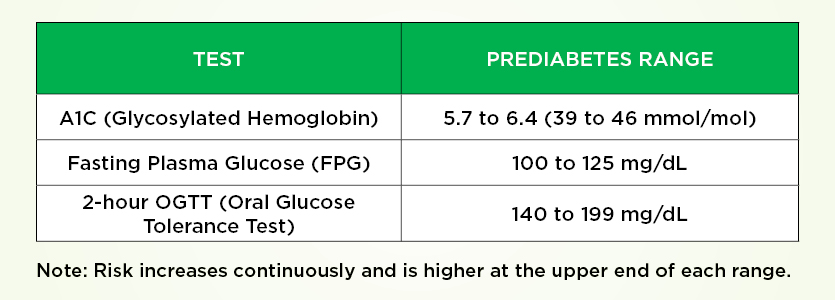
This post was written by Dr. Reshma Khatri, PPG – Pediatrics.
Prediabetes is a condition where an individual is at high risk of developing diabetes. It often has no symptoms, so it may go unnoticed without screening. In this post, we will define the parameters of this condition and arm parents with the red flags to watch for.
How is prediabetes diagnosed?
Prediabetes is diagnosed using blood tests. The values that correlate with a diagnosis are:

Who is at higher risk?
People with the following characteristics are at increased risk for prediabetes:
- Higher BMI or increased fat tissue (including visceral fat)
- Insulin resistance
- Family history of diabetes
- Sedentary lifestyle or low physical activity
- Unhealthy eating habits (high in processed foods or sugary snacks)
Warning signs in children
If the following apply to your child, it could be a red flag for prediabetes:
- Has rapid weight gain over 6–12 months (more than expected for age)
- BMI over the 85th percentile, if 10 years or older, with risk factors detailed above
- Shows signs of insulin resistance (e.g., dark patches on neck creases)
- Has a family history of diabetes
Talk to your physician about checking your child’s HbA1c, especially around age 11 or during annual wellness exams. During puberty, weight and height naturally increase, but regular checkups ensure changes are within normal limits.
How to lower the risk (or reverse prediabetes)
Prediabetes is often reversible through lifestyle modification and is the cornerstone of diabetes prevention. The recommendations include:
Physical activity: Aim for at least 60 minutes daily of activity that increases the heart rate (moderate to vigorous activity). Check with your provider if your child has any pre-existing heart or health issues to ensure it is safe for the child to exercise.
Nutrition:
- Choose home-cooked meals, 5 servings of fruits and vegetables daily. Watch portion sizes.
- Cook with healthy fats like olive or coconut oil.
- Limit fast foods and processed snacks.
Screen time: Keep screen time to less than 2 hours daily to avoid prolonged snacking and inactivity.
Sleep: Aim for 9-12 hours of sleep for 6-12 year olds and at least 9 hours for the older kids.
Involve the whole family! Healthy lifestyle changes work best when everyone participates. This helps in not making the child feel bad as she/he will not even realize that these changes are made.
Monitoring and support
Lean on your child’s care team to continue to monitor their condition and stay in their best health. These measures might include:
- Blood tests (HbA1c, glucose) are typically done at least once a year.
- Nutritional counseling or a weight management program.
- Talk to your healthcare provider about personalized recommendations.
Articles
Prediabetes: a high-risk state for diabetes development
Evaluation and Treatment of Prediabetes in Youth



